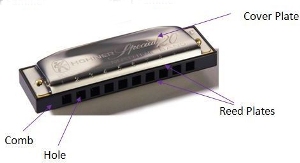Although we think of the harmonica as a single instrument, it actually comes in a number of models, types and prices – a great range that means there’s something to meet everyone’s needs. Standard types are the diatonic, chromatic, tremolo and octave, each offering a different specialty. For example, if you are a beginner, the most popular model and type is the diatonic in the key of C, the Hohner Special 20 being among the most popular as the easiest on which to start learning – though it’s also suitable for all levels of players.
In addition to health benefits – such as controlled breathing and its relaxation and recreational values – learning to play the harmonica is a beautiful way of expressing emotions and a fun way to entertain friends and family. But when you first pick up a harmonica to start learning, it’s a good idea to get to know it a little better.
Meet Your Harmonica

Knowing the different parts is a basic part of your introduction to the harmonica. Let’s stick with the diatonic as our working example, though it shares similar structure and parts with others.
- It has 10 holes with 2 reeds each. The holes are simply where you blow and draw air and they are numbered from 1 to 10.
- A comb supports the reed plates and creates the holes. Combs are made of wood, metal or plastic.
- Two reed plates hold the reeds, which are securely attached in parallel by nails or screws.
- The twenty reeds (ie, two reeds in each of the 10 holes) vibrate when blowing and drawing air. Reeds are usually made of brass.
- Sturdy cover plates hold the parts in place and protect the harmonica. They are made of various materials, such as brass plated with chrome, silver or gold. Some covers are plastic or stainless steel.
After getting familiar with the physical components of your harmonica, let’s take a close-up look at what happens when you play it.
The first hole: When you blow into this hole you produce the note C, and when you draw air on the same hole you get the note D. Starting from this point, blowing into the holes from 1 to 10 gives you notes C E G C E G C E G C and drawing air produces notes D G B D F A B D F A. Taking time to familiarize yourself with these notes will make learning easier as you progress with your instrument.

Comments
Got something to say? Post a comment below.